Former Working Lads' Institute
1884-7, educational institution with shop, George Baines, architect, reduced in size 1899-1900, closed 1973, converted to flats in 1997
The former Working Lads' Institute, 279-281 Whitechapel Road
Contributed by Survey of London on Nov. 30, 2017
This impressively tall gabled building was erected in 1884–5 and extended at the back in 1886–7 as a Working Lads’ Institute, to promote the welfare of employed boys aged thirteen and over through evening education and exercise. Facilities included a reading room, a lecture hall, a swimming bath-cum- gymnasium, classrooms and dormitories in up to six storeys across a deep site. The architect was George Baines, the contractor William Gregar of Stratford, with B. E. Nightingale of Lambeth having built the foundations. The swimming bath was excavated by about fifty unemployed men through the Mansion House Relief Fund. The loosely Renaissance red-brick and Portland stone-fronted Institute remains a landmark on Whitechapel Road. It was once hailed as ‘the loftiest building in the East End’.1
The Education Act of 1870 provided for universal education up to the age of thirteen, and thereby gave rise to concerns about the wellbeing and oversight of teenage males, particularly against the backdrops of growing unemployment and poverty and perennially poor housing. The origins of the Working Lads’ philanthropic project were with Henry Hill, junior, a well-connected City merchant, who with J. E. Saunders, Chairman of the Coal, Corn and Finance Committee of the Corporation of London, and others launched an appeal and in 1876 established an avowedly experimental institute in a house at 12 Mount Place (later 152 Whitechapel Road). Success and the stirrings of similar initiatives elsewhere in London and beyond encouraged a move to purpose-built premises. The plot to the west of Whitechapel Station (No. 275) was acquired in 1882. After a competition, a scheme designed by Henry Shaw was selected, only for the site to be taken by the District Railway Company, which in 1884 acquired the plot on the other side of the station for the Institute.2 That site had been owned by John Earley Cook, whose father of the same name, one of London’s most promiscuous landlords, owned the two shophouses here by 1818. A china warehouse had been built to the rear in 1845.3
Terms could not be agreed with Shaw, so he was dismissed and new designs were sought from Baines, recently arrived in London from Accrington. With royal patronage and a leading banker, Frank A. Bevan of Barclay, Bevan, Tritton & Co., as treasurer, contributions from the Corporation of London, livery companies, City vestries and wealthy individuals were amassed for the novel enterprise. Costs of more than £12,000 meant that construction had to be phased, permitting two formal openings, in October 1885 and April 1888. The premises were said to be extensive enough to accommodate 1000 boys in all. The later back part comprised the swimming-bath (52ft by 35ft), gymnasium and lecture hall, which could hold about 600. Bathing was thought particularly beneficial, as many of the lads were ‘living in confined rooms, and perhaps engaging in unhealthy occupations’.4 The lecture hall had stained glass, gifted by Hill and designed and executed by A. O. Hemming & Co. of Margaret Street. Three windows bore representations of Art, Religion and Industry and nine semi-circular ceiling lights depicted the seasons and sports. More land to the rear up to Winthrop Street had been secured in 1885 through a donation from Princess Louise, anonymously given, to provide a recreation ground, and to prevent extension of the music hall adjoining to the east (see 285 Whitechapel Road). Laying out as a children’s playground by the Metropolitan Public Gardens Association had involved altering plans for the back part of the Institute to make the open ground a bit larger.5
Boys were charged small subscriptions, but funding the Institute’s running costs was difficult, especially after 1891 following a banking crisis and reform of the City’s parochial funds with redirection of that source of money towards technical education. The Institute had to be put up for sale, with a plea for a rescue. A saviour was found in the shape of the Rev. Thomas Jackson, a Primitive Methodist minister and leader of an evangelical mission in Clapton, who bought the establishment for £8,000 in 1897. The original purpose was maintained – ‘to supply a counter attraction to the low Music Halls and other east end resorts for the young, which are so fatal to their social and moral well-being’,6 and Hill’s son and Bevan, now the first chairman of Barclay and Co. Ltd, remained on the management committee. However, the capacious rear section of the building (bath, gym and lecture hall) had to be sold and demolished in 1899–1900 to make way for the Whitechapel & Bow Railway. John Price, the line’s contractor, rebuilt the surviving six-storey back parts to reworked arrangements by George Baines and Son. The Winthrop Street playground, ‘but a very little place’, had also to be given up, even though since its opening in 1887 it had been used to an ‘enormous extent’ by local children.7
The purchase price of more than £20,000 from the railway company cleared debts and put the Institute on a secure financial footing. The now more compact premises boasted an unchanged full-width reading room for 150 on the first floor, amply lit from the front by the three bay windows. This was above a refreshment room and a lettable shop unit, first taken by a watchmaker. The smaller lecture hall at the back incorporated some of the stained glass – one round-headed window depicting the Tree of Life survives. This hall was above a reduced gymnasium – the railed flat roof to the back supplied additional exercise space but there was no more swimming. There were fireproof floors and a stone staircase, five classrooms and two workshops on the second floor, and accommodation for the superintendent and dormitories above, some with more of the displaced stained glass. The dormitories were adapted and in due course extended into other spaces for the Whitechapel Primitive Methodist Mission to provide a ‘home for friendless and orphan lads’. While making the establishment overtly religious, Jackson kept the premises open to all aged thirteen to eighteen, including many who were Jewish, and take-up shifted to a poorer section of society.8
Jackson, who died in 1932, remained active in Whitechapel, also working amongst women and prisoners and against sweated labour. The Whitechapel Mission extended across to its present site (208–212 Whitechapel Road) in 1906. The former Institute building was developed to function largely as a hostel for boys and young men, mostly those aged 17 to 21, increasingly taken from courts, with Jackson as a probation officer. The Mission moved to new premises at 208–212 Whitechapel Road in 1971 and the Institute building was sold. The upper storeys were converted to be nine flats in 1997 and the façade was restored with lettering and lamps reinstated in the High Street 2012 works.9
-
William Potter, Thomas Jackson of Whitechapel, 1929, p. 68: This account is largely based on that by Joanna Smith in an unpublished report of 2008 for English Heritage, Historic England London Historians’ File TH269: The Builder, 14 Feb 1885, p. 255; 10 April 1886, p. 561: Building News, 6 Nov 1885, p. 726: London Metropolitan Archives (LMA), District Surveyors Returns (DSR) ↩
-
_ The Builder_, 30 Sept 1876, p. 962: LMA, ACC/1926/C/9: Transport for London Group Archives (TfLGA), LT002009/465 ↩
-
Tower Hamlets Local History Library and Archives, P/HLC/1/14/8–9: DSR ↩
-
LMA, ACC/1926/B/020; ACC/1926/C/008 ↩
-
The Builder, 25 July and 3 Oct 1885, pp. 140, 484; 28 April 1888, p. 310: Pall Mall Gazette, 31 Oct 1885, p 6: LMA, CLC/011/MS11097/3, pp. 297, 307–8; CLC/011/MS11097/4, pp. 25, 70, 102 ↩
-
LMA, ACC/1926/C/11 ↩
-
London County Council Minutes (LCC Mins), 24 Oct 1899, p. 1453: DSR ↩
-
LMA, ACC/1926/B/015; ACC/1926/C/11: Daily News, 2 Nov 1885: LCC Mins, 9 Oct 1900, p. 1212: TfLGA, LT002009/465: Post Office Directories: The National Archives, IR58/84806/2358–60: William Potter, Thomas Jackson of Whitechapel, 1929, pp. 60–5 ↩
-
Bridget Cherry, Charles O'Brien and Nikolaus Pevsner, The Buildings of England, London 5: East, 2005, p. 430: Tower Hamlets planning applications online ↩
The Working Lads' Institute
Contributed by David Charnick on July 31, 2016
The Working Lads’ Institute was founded in 1878 by a city merchant called Henry Hill. It was one of many nineteenth-century initiatives to give urban youth a more legitimate outlet for their energies. Aimed at young men who had to work for a living (rather than the local poor), the Institute offered them the chance to better themselves and thus improve their employment situation. From its original site at 12 Mount Place [Mount Street?], Whitechapel Road, it moved in 1885 to new premises at 285 Whitechapel Road. As can be seen from the entrances to the building, the facilities offered included not only a lecture hall and a library, but also a swimming bath and a fully-equipped gymnasium with an instructor: a healthy mind in a healthy body.
The project was not to succeed however. By 1896 the Institute was running out of money and was threatened with closure. Henry Hill wrote a letter to _The Christian _appealing for help to keep the Institute open. This was read by Revd Thomas Jackson, a Primitive Methodist preacher who had been active in Bethnal Green, Walthamstow and Clapton. Jackson was able to buy the Institute, which he transformed as a Primitive Methodist mission to help friendless and homeless boys who would otherwise be on the streets. It operated also as a hostel, providing beds for homeless boys.
Outdoor activity was encouraged, many boys being sent to work on farms in Devon. In 1901 the Mission acquired a property on Marine Parade, Southend, which was used to provide holidays and convalescent stays for poor boys. The mission performed probation work, though this ceased when it was given a house called Windyridge at Thorrington in Essex, which became the mission’s probation wing. The Institute remained a hostel for boys, principally in the age group 17 to 21.
In 1943 the hostel began to move out of Whitechapel to Whitechapel House, Tulse Hill. However, in 1971 the compulsory purchase of Whitechapel House forced the Mission to move the hostel again. It returned to Whitechapel, and resumed its activities at 3 Maples Place. Though the hostel closed in 1973, it provided the foundation of the Whitechapel Mission, which is still active and providing support for the homeless.
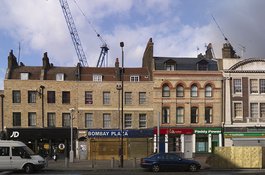
Whitechapel Road panorama in 2014
Contributed by Chris Redgrave
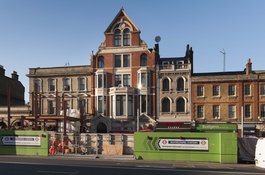
275-287 Whitechapel Road in early 2018
Contributed by Derek Kendall
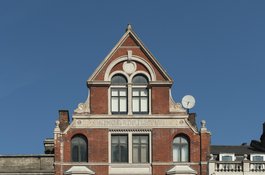
279-281 Whitechapel Road in 2016
Contributed by Derek Kendall
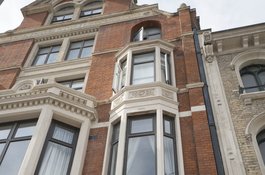
281 Whitechapel Road, facade detail, 2017
Contributed by Derek Kendall
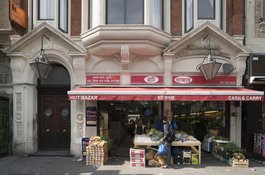
279-281 Whitechapel Road, ground-floor facade, 2017
Contributed by Derek Kendall
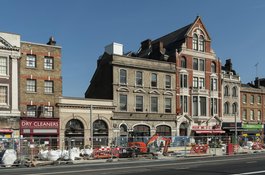
273-281 Whitechapel Road in 2016
Contributed by Derek Kendall
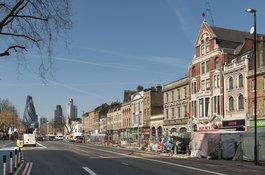
From 281 Whitechapel Road looking west in 2016
Contributed by Derek Kendall